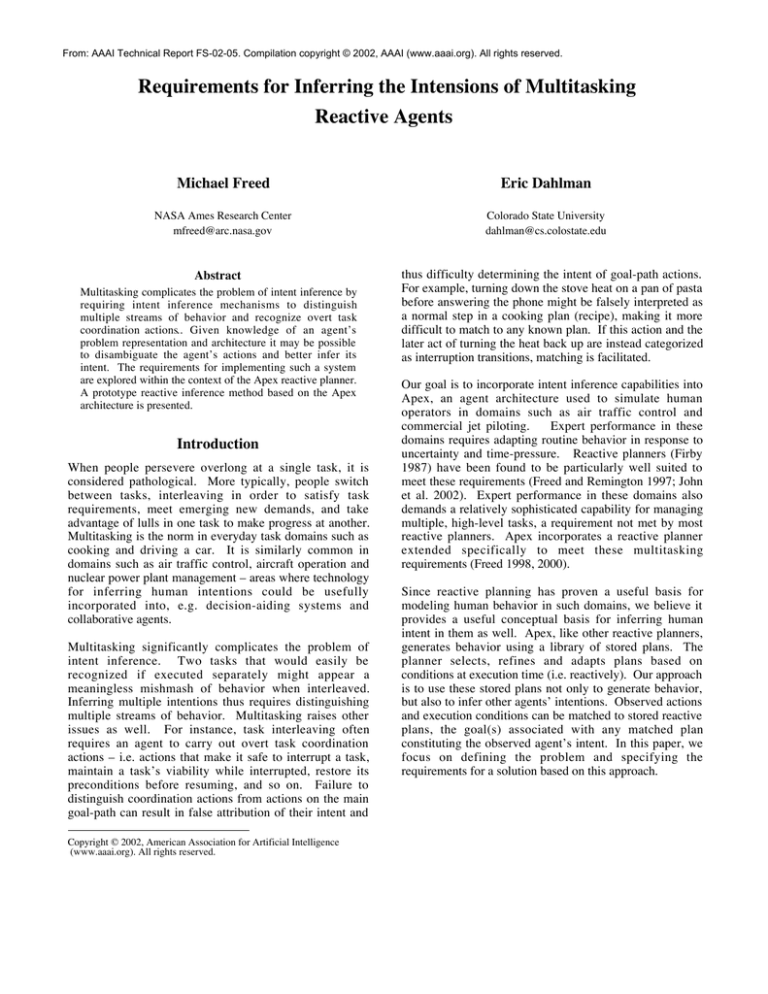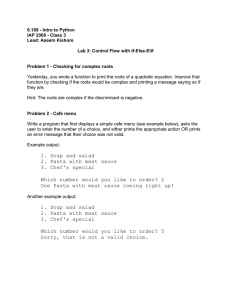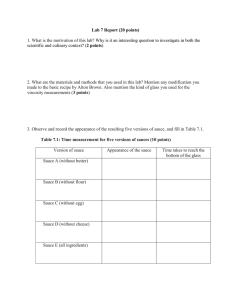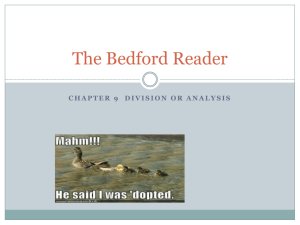
From: AAAI Technical Report FS-02-05. Compilation copyright © 2002, AAAI (www.aaai.org). All rights reserved.
Requirements for Inferring the Intensions of Multitasking
Reactive Agents
Michael Freed
Eric Dahlman
NASA Ames Research Center
mfreed@arc.nasa.gov
Colorado State University
dahlman@cs.colostate.edu
Abstract
Multitasking complicates the problem of intent inference by
requiring intent inference mechanisms to distinguish
multiple streams of behavior and recognize overt task
coordination actions.. Given knowledge of an agent’s
problem representation and architecture it may be possible
to disambiguate the agent’s actions and better infer its
intent. The requirements for implementing such a system
are explored within the context of the Apex reactive planner.
A prototype reactive inference method based on the Apex
architecture is presented.
Introduction
When people persevere overlong at a single task, it is
considered pathological. More typically, people switch
between tasks, interleaving in order to satisfy task
requirements, meet emerging new demands, and take
advantage of lulls in one task to make progress at another.
Multitasking is the norm in everyday task domains such as
cooking and driving a car. It is similarly common in
domains such as air traffic control, aircraft operation and
nuclear power plant management – areas where technology
for inferring human intentions could be usefully
incorporated into, e.g. decision-aiding systems and
collaborative agents.
Multitasking significantly complicates the problem of
intent inference. Two tasks that would easily be
recognized if executed separately might appear a
meaningless mishmash of behavior when interleaved.
Inferring multiple intentions thus requires distinguishing
multiple streams of behavior. Multitasking raises other
issues as well. For instance, task interleaving often
requires an agent to carry out overt task coordination
actions – i.e. actions that make it safe to interrupt a task,
maintain a task’s viability while interrupted, restore its
preconditions before resuming, and so on. Failure to
distinguish coordination actions from actions on the main
goal-path can result in false attribution of their intent and
Copyright © 2002, American Association for Artificial Intelligence
(www.aaai.org). All rights reserved.
thus difficulty determining the intent of goal-path actions.
For example, turning down the stove heat on a pan of pasta
before answering the phone might be falsely interpreted as
a normal step in a cooking plan (recipe), making it more
difficult to match to any known plan. If this action and the
later act of turning the heat back up are instead categorized
as interruption transitions, matching is facilitated.
Our goal is to incorporate intent inference capabilities into
Apex, an agent architecture used to simulate human
operators in domains such as air traffic control and
commercial jet piloting.
Expert performance in these
domains requires adapting routine behavior in response to
uncertainty and time-pressure. Reactive planners (Firby
1987) have been found to be particularly well suited to
meet these requirements (Freed and Remington 1997; John
et al. 2002). Expert performance in these domains also
demands a relatively sophisticated capability for managing
multiple, high-level tasks, a requirement not met by most
reactive planners. Apex incorporates a reactive planner
extended specifically to meet these multitasking
requirements (Freed 1998, 2000).
Since reactive planning has proven a useful basis for
modeling human behavior in such domains, we believe it
provides a useful conceptual basis for inferring human
intent in them as well. Apex, like other reactive planners,
generates behavior using a library of stored plans. The
planner selects, refines and adapts plans based on
conditions at execution time (i.e. reactively). Our approach
is to use these stored plans not only to generate behavior,
but also to infer other agents’ intentions. Observed actions
and execution conditions can be matched to stored reactive
plans, the goal(s) associated with any matched plan
constituting the observed agent’s intent. In this paper, we
focus on defining the problem and specifying the
requirements for a solution based on this approach.
Procedure Representation
Apex represents plan knowledge using Procedure
Definition Language, a notation that includes elements
specialized for multitask management. The central
language construct in PDL is a procedure, which contains
at least an index clause and one or more step clauses. The
index uniquely identifies the procedure and describes a
class of goals the procedure can be used to accomplish.
Each step clause describes a subtask or auxiliary activity
prescribed by the procedure.
(procedure
(index (cook pasta sauce in ?saucepan))
(profile hands eyes)
(step s1 (fetch ?saucepan))
(step s2 (fetch pasta sauce => ?sauce))
(step s3 (pour ?sauce into ?saucepan)(waitfor ?s1 ?s2))
(step s4 (place ?saucepan on stove burner => ?b)
(waitfor ?s3))
(step s5 (turn burner ?b to med) (waitfor ?s3))
(step s6 (stir sauce)
(period :recurrent :recovery (1 minute))
(waitfor ?s4 ?s5))
(step s7 (turn burner ?b to off)
(waitfor (bubbling sauce)))
(step end (terminate) (waitfor ?s7))
(step int (turn burner ?b to low)
(waitfor (interrupted ?self)))
(step res (turn burner ?b to med)
(waitfor (resumed ?self))))
Figure 1. Example PDL procedure
The procedure in Figure 1, representing a method for
cooking pasta sauce, illustrates several important aspects of
PDL. A procedure’s steps are not necessarily carried out in
the order listed or even in a sequence. Instead, steps are
assumed to be concurrently executable unless otherwise
specified. If step ordering is desired, a waitfor clause is
used to specify that the completion (termination) of one
step is a precondition for the start (enablement) of another.
In the example above, the step labeled s1 does not contain
a waitfor clause and thus has no preconditions; it can begin
execution as soon as the procedure is invoked. Steps s4
and s5 must wait for s3 to complete but are not otherwise
constrained by the logic of the procedure. They can
execute in parallel unless some factor not specified within
the scope of the procedure prevents this. For example, if
both steps require use of the right hand, one will have to
wait for the other to complete. The step labeled int
specifies what to do if the procedure is interrupted. This
step specifies a contingent activity; the procedure can run
to completion without ever executing this step.
Procedures are invoked to carry out an agent’s active tasks.
Tasks, which can be thought of as agent goals 1, are stored
on a structure called the agenda internal to the agent
architecture. When a task on the agenda becomes enabled
(eligible for immediate execution) what happens next
depends on whether or not the task corresponds to a
primitive action. If so, the specified action is carried out
and then the task is terminated.
If the task is non-primitive, the planner retrieves a
procedure whose index clause matches the task. For
example, a task of the form (cook pasta sauce in pan-5)
matches the index clause of the procedure above. The
procedure would thus be retrieved once the task became
enabled. Step clauses in the selected procedure are then
used as templates to generate new tasks, which are then
added to the agenda. In this example, there are eight steps
so eight new tasks will be created. The process of
decomposing a task into subtasks on the basis of a stored
procedure is called task refinement. Since some of the
tasks generated through this process may themselves be
non-primitive, refinement can be carried out recursively.
This results in the creation of a task hierarchy.
PDL and its interpreter (the reactive planner) support
several facets of multitask management including
concurrency control, graceful interruption handling and
efficient resource scheduling under uncertainty (Freed
1998). A simple example of concurrency control is
illustrated by step s4, s5 and s6 in the above procedure. In
this case, the steps are constrained to converge – i.e. s4 and
s5 can run in parallel but both must complete before s6 can
begin. Other control idioms such as synchronization and
racing can also be expressed. The procedure steps labeled
int and res illustrate graceful interruption handling. A
simple multitasking approach would treat tasks
analogously to processes in an operating system: when
interrupted, the system would save state (remember where
it left off) but otherwise transition to the new task abruptly.
In PDL, it is possible to express interrupt- and resume-time
behaviors that minimize undesirable consequences of
interruption. The profile clause is used to declare
resources needed to carry out the task. Integrated
scheduling mechanisms automatically detect resource
conflicts (i.e. when two enabled tasks require use of the
same resource) and invoke priority-based scheduling to
resolve the conflict. Moreover, as circumstances change
during task execution, priority can be reevaluated, possibly
resulting in an ongoing task becoming interrupted to allow
execution of a new or newly important task. As a result,
Apex agents use limited resources efficiently and
adaptively.
1
The term task generalizes the concept of a classical goal – i.e. a welldefined state, expressible as a proposition, that the agent can be seen as
desiring and intending to bring about (e.g. “be at home”). Tasks can also,
e.g., encompass multiple goals (“be in car seat with engine started and
seatbelt fastened”), specify goals with indefinite state (“finish chores”),
specify goals of action rather than state (“scan security perimeter ”), and
couple goals to arbitrary constraints (“be at home by 6pm”).
Requirements
The basic process underlying our intent inferencing
approach is to match observed events, including agent
actions and task environment occurrences, to PDL
procedures. Successfully implementing this approach
requires considering the information content and semantics
of these procedures – i.e. the behavior of the reactive
planner that interprets them. Our analysis reveals two main
sources of difficulty in using these procedures in their
current form. First, agents in realistic task environments
will have limited ability to observe match-relevant events.
Some events will be unobservable in principle – e.g.
mental actions prescribed by steps of an executing
procedure. Other important events may go unobserved if
the inferring agent needs to share sensor resources with
tasks other than observing the performing agent.
Moreover, many applications of an intent inference
capability, e.g. advising an agent or taking over its tasks
when needed, require inferring intent prior to completion
of the procedure. Thus intent must be inferred before
observing all the actions that could be observed.
With observations providing only incomplete information,
exact matches between procedures and observed events
cannot be expected. To assess partial matches, inference
mechanisms must account for variability in the degree to
which given observations discriminate among potential
matches – i.e. their diagnosticity. One possibility is to
represent diagnostic information (e.g. prior probability that
an observed action, action eliciting event, or decisionshaping factor implies the use of a given procedure)
directly in the procedure. This is an especially attractive
option for routine procedures such as those generally used
in reactive planners since the information can be obtained
empirically. However, PDL does not currently provide
notational elements for representing this kind of
information. Thus, one requirement for implementing our
approach is to extend PDL for this purpose.
A second kind of challenge to using PDL procedures as
the basis of an intent inference approach is the relatively
complex semantics of these procedures. In particular,
procedures do not fully specify behavior. Actions can be
specified abstractly, contingently and with parametric and
constraint information whose effect on execution depends
on what other tasks are active and what circumstances hold
in the task environment. Thus, the relationship between
the actions of an Apex agent and underlying procedures
can only be understood in terms of the reactive planner that
interprets and executes those procedures. Several facets of
the reactive-planner’s behavior and their implied
requirements for intent inference are considered below.
The first three, hierarchical decomposition, reactivity and
contingency handling, are relevant to reactive planners in
general. The latter three, interruption transitions,
concurrency control and resource scheduling, are more
specific to the way Apex manages multiple tasks.
Hierarchical decomposition Non-primitive steps of a
procedure are recursively decomposed into substeps,
producing a task hierarchy. In itself, this raises few issues
for intent inference since direct observations of action can
be handled uniformly with inferred actions. For instance,
directly observing an agent pour sauce into a pan can be
used to infer the intention of warming up pasta sauce; this
in turn can be used to infer the intention of cooking
spaghetti. However, two processes occurring during task
decomposition imply requirements for our approach. First,
variables may become bound. For example, invoking the
procedure in Figure 1 binds a variable that specifies a
particular saucepan. For inferring intent, variable bindings
constitute matching constraints.
Second, task
decomposition can follow selection between alternative
procedures (and thus alternative decompositions).
Observing a particular procedure implies constraints on the
value of selection criteria expressed in the calling
procedure.
Reactivity Reactive procedures include steps that are
enabled in response to external events such as the contents
of a pan starting to boil. Intent inferencing mechanisms
must use observations of such events as evidence for or
against procedure matches in the same way it uses
observations of agent actions. One important consequence
of reactivity is that the order in which steps will be carried
out can vary across instances of executing a procedure, as
directed by exogenous enabling events. Intent inference
mechanisms must therefore be able to match to a space of
possible execution paths.
Contingency handling Reactive procedures may include
contingent steps – i.e. actions to be carried out only in
particular conditions. Since these may or may not occur
during a particular instance of executing a procedure, the
set of actions constituting a correct execution of the
procedure can vary. Inference mechanisms must be able to
match to a space of possible action sets.
Concurrency control The steps of PDL procedures are
concurrent by default. Concurrency constraints may be
expressed in several ways. Waitfor clauses and task
control actions (such as task termination) can be used to
arrange several control strategies such as fixed ordering,
convergence, racing, staggered starts and synchronization.
The specified strategy is an important matching constraint
for intent inference mechanisms since people often use a
range of procedures with common constituent actions but
varying ordering strategy.
Interruption transitions People often carry out special
actions to minimize the risks and lost progress due to task
interruption (e.g. turning down the heat on rapidly heating
sauce to avoid a mess). Other actions may be carried out
during the interruption interval to maintain task viability or
upon resumption to restore preconditions violated during
the interruption interval. Intent inference mechanisms
must correctly categorize these as interruption transition
actions and not as actions on the main goal-path, otherwise
it will be difficult to find a correct match.
Resource scheduling People engage in a range of explicit
and implicit behaviors to make multitask behavior more
time-efficient. They may interleave tasks that could be
carried out serially or take advantage of slack time in the
use of resources by one task to make progress at another
(e.g. clean up the kitchen while waiting for the sauce to
heat). The resulting interleaving of behaviors requires
matching mechanisms to decide which actions can be
grouped together as serving a common intention. Some
actions will unambiguously belong to certain procedures
and not others. Others however may be ambiguous (e.g.
something may be put in the refrigerator either to store it or
cool it down). In these cases, intent inference mechanisms
will need to treat the scheduling efficiency behavior of the
planner as a constraint on matching. More complex
reasoning about this process is required if intent inference
mechanisms are employed to check the behavior of other
agents and warn of possible error. For example, human air
traffic controllers and pilots under high workload
sometimes “tunnel” on a task (remain focused on it
overlong) or “thrash” (move erratically and rapidly
between tasks).
Technical Approach
The intent of a reactive planner like Apex is contained in
the set of tasks that are currently being pursued by the
planner. The inferred intent of such an agent can be
modeled as a set of hypothetical procedures that the agent
may be executing. An attractive approach for representing
this set in a reactive planner like Apex is through the use of
hypothesis procedures derived from the PDL procedures
controlling the observed agent. An executing hypothesis
procedure monitors for events that strengthen or weaken its
associated hypothesis and adjust a probability reflecting the
likelihood of the hypothesis. This information is directly
available to the planner that can then choose to act on the
inferred results accordingly.
The driving goal is to meet the requirements in the
previous section. An important step toward that end is the
automatic synthesis of hypothesis procedures from a PDL
plan library into a library of inference procedures. In order
to increase the ultimate usefulness of intent inference in
Apex a knowledgeable user should be able to include extra
advice about the domain. This provides and avenue to
include inference information that may not be expressed in
the domain or effectively inferred by the default approach.
As an example lets consider a procedure for recognizing
the c! ook pasta sauce task based on the actions observed.
To simplify this example we will assume our observing
agent has a perfect sensor that will create events like
(observed stir sauce)! for the visible actions performed by
the other agent. Given these assumptions a potential
recognition procedure can be seen in Figure 2.
The approach we used to derive these recognition
procedures is to analyze the graph of potential step
transitions within the procedure. As the agent perceives
new events these may indicate transitions within this graph
and the associated procedure. Because there may be
several active tasks capable of generating the event the
probability that the event did belong to that task must also
be calculated. The values for the example in Figure 2
followed from the fact that there were 10 recipes that made
use of a saucepan in the plan library while only one of
them was for pasta sauce.
While runtime probability calculations may be more
accurate precalculated values open up the possibility
simplifying the resulting hypothesis procedures. We can
see the effect of this simplification on the pasta sauce
recognition procedure where there will not need to be any
checks for (observed stir sauce) since these observations
will not have an effect on the inferred probability in the
case. In noisier domains where we need to contend with
errors in sensors and partial observability it may not be
beneficial to discard these events as they would help
strengthen the make pasta sauce hypothesis.
Once the transition graph for a procedure has been
generated the associated hypothesis procedures can be
created. There is some flexibility in how this can be done
but the general approach is to make the hypothesis
procedure’s index be a predictive event. For instance, in
the case of making pasta sauce stirring the sauce is a highly
predictive event. However, that event may occur too late
in the process for the inference to be useful to an agent who
is allergic to tomatoes. There is also a danger in selecting
the first event as the trigger since the agent may become
overloaded with too many “fanciful” hypotheses.
(procedure ;; Cooking pasta sauce?
(index (observed fetch saucepan))
(step s1 (set-probability (cook pasta sauce) 0.1))
(step s2 (set-probability (cook pasta sauce) 1.0)
(waitfor (observed fetch pasta sauce)))
(step done (set-probability (cook pasta sauce) 0.0)
(waitfor (observed turn burner ?b to off)))
(step end (terminate) (waitfor ?done))
(step interrupted
(set-probability (interrupted cook pasta sauce)
(probability (cook pasta sauce)))
(waitfor (observed turn burner ?b to warm)))
(step resumed
(set-probability (interrupted cook pasta sauce)
0.0)
(waitfor (observed turn burner ?b to hi))))
Figure 2. An example hypothesis procedure.
Future Work
The problem of embedding intent inference into the Apex
reactive planner requires further examination before the
full requirements are understood. The hypothesis procedure
approach suggested here appears promising in that it
meshes well with the reactive planning paradigm and
provides useful information in several toy examples.
Currently, however, only the most elementary types of
evidence, observed events and procedure structure, are
considered when generating the hypothesis procedures.
Although this allows successful intent inference in some
cases, a great deal more information about the task
execution context, task environment regularities and
procedure semantics could still be employed improve
inference accuracy. Our examples indicate numerous open
questions such as the need to consider how much effort can
and should be dedicated to inferring the intent of other
agents in the environment. Currently there is no concept of
the utility of making an inference this need to be captured
and possibly even allowing the agent to adjust it to the
situation at hand. In future work we will assess the
effectiveness of our approach with more rigorous
evaluation on larger more involved domains.
References
Engelmore, R., and Morgan, A. eds. 1986. Blackboard Systems. Reading, Mass.: Addison-Wesley.
Firby, R.J. 1989. Adaptive Execution in Complex
Dynamic worlds. Ph.D. thesis, Yale University.
Freed, M. (2000) Reactive Prioritization. Proceedings 2nd
NASA International Workshop on Planning and Scheduling
for Space. San Francisco, CA.
Freed, M. (1998a) Simulating Human Behavior in
Complex, Dynamic Environments. Doctoral Dissertation.
Department of Computer Science, Northwestern
University.
Freed, M. (1998b) Managing multiple tasks in complex,
dynamic environments. In Proceedings of the 1998
National Conference on Artificial Intelligence. Madison,
Wisconsin.
Freed, M. and Remington, R. (1997) Managing decision
resources in plan execution. Proceedings of the Fifteenth
International Joint Conference on Artificial Intelligence.
Nagoya, Japan.
Gat, Erann. 1992. Integrating planning and reacting in
heterogeneous asynchronous architecture for controlling
real-world mobile robots. In Proceedings of 1992 National
Conference on Artificial Intelligence.
John, B. E., Vera, A. H., Matessa, M., Freed, M., and
Remington, R. (2002) Automating CPM-GOMS. In
Proceedings of CHI’02: Conference on Human Factors in
Computing Systems. ACM, New York, pp. 147-154.






